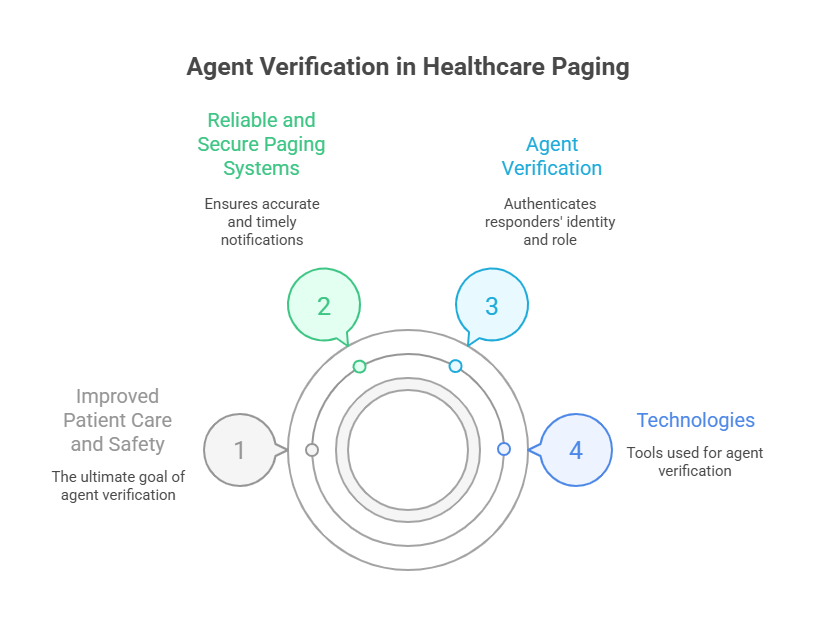How Does Agent Verification Improve Healthcare Emergency Paging?

In healthcare, timely and accurate communication during emergencies is essential for patient outcomes. A critical challenge in emergency paging systems is ensuring that messages reach the right healthcare professionals. Agent verification enhances accuracy by ensuring that the right individual receives the paging message. This improvement reduces errors, accelerates responses, and enhances patient care.
What Does Agent Verification Mean?
Agent verification improves healthcare emergency paging by ensuring that the emergency message reaches the correct person, without confusion or delay. It uses technology to authenticate the identity of the person receiving the page, verifying that they have the appropriate role or responsibility to respond. This creates an extra layer of security and accuracy, which is crucial in critical healthcare situations.

The Impact of Delays and Miscommunications
The primary issue with traditional paging systems is that messages can be missed or misdirected. Healthcare professionals often face high workloads and multiple shifts, making it difficult to ensure that the right person receives an emergency message in real-time. This can lead to delayed responses, miscommunications, and in some cases, critical patient care lapses. Healthcare providers often struggle with ensuring that their emergency paging systems are both accurate and reliable, as incorrect or delayed responses can impact patient outcomes and staff effectiveness.
Enhancing Emergency Paging with Agent Verification
Agent verification is the process of confirming that the intended recipient of an emergency paging message is the correct individual, ensuring that messages are delivered accurately and acted upon promptly. By integrating agent verification into the emergency paging process, healthcare organizations can significantly reduce errors, miscommunications, and delays. This is typically done through digital platforms and secure mobile applications, where verification methods such as two-factor authentication, biometric scanning, or role-based access control are used to confirm the identity of the recipient.
The Step-by-Step Process of Agent Verification
Emergency Alert Trigger: The system sends an urgent page to the designated individual or team.
Verification Method: The recipient confirms their identity via secure methods (e.g., a code, facial recognition, or an app).
Message Delivery: Once verified, the emergency message is delivered, and the recipient acknowledges it.
Action Taken: The verified individual responds to the emergency as instructed, minimizing delays.
How Staffingly Helps?
Staffingly provides scalable, secure agent verification solutions for healthcare environments. Integrated with existing paging systems, it ensures that alerts are sent to the correct healthcare professionals. Automated verification confirms the recipient’s identity before they receive critical messages, reducing miscommunication risks. Staffingly’s digital authentication methods ensure only authorized personnel access urgent messages, speeding up responses and improving patient care.

Key Benefits of Agent Verification in Healthcare
Increased Accuracy: Reduces the chances of messages being misdirected.
Faster Response Times: Automated verification speeds up the process, ensuring quick action.
Improved Security: Only authorized individuals can access confidential information.
Better Patient Care: Faster communication leads to more timely care and improved outcomes.
Operational Efficiency: Streamlines the paging process, reducing manual errors and delays.
Scalability: Staffingly’s platform adapts to your healthcare facility, managing emergencies even during peak times.
By implementing agent verification, healthcare providers can improve response times and prevent errors. Staffingly helps ensure your communication system is secure, scalable, and efficient.
What Did We Learn?
Agent verification boosts the reliability and efficiency of emergency paging systems. By verifying the recipient, healthcare organizations can reduce delays, prevent miscommunications, and enhance response times. Secure verification methods add another layer of security, ensuring critical information reaches the right personnel promptly. This improves patient care and streamlines operations.
Staffingly’s solutions provide the tools healthcare providers need to improve communication, automate verification, and uphold high-security standards. Healthcare teams can respond more effectively during emergencies, ultimately improving patient outcomes.
What People Are Asking?
 Book a Demo to Build Your Team Today!
Book a Demo to Build Your Team Today!



 Read Case Studies
Read Case Studies 


 Virtual Medical Assistants
Virtual Medical Assistants



